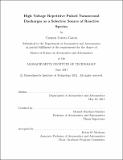| dc.contributor.advisor | Manuel Martínez-Sánchez. | en_US |
| dc.contributor.author | Guerra García, Carmen | en_US |
| dc.contributor.other | Massachusetts Institute of Technology. Dept. of Aeronautics and Astronautics. | en_US |
| dc.date.accessioned | 2011-11-18T19:29:46Z | |
| dc.date.available | 2011-11-18T19:29:46Z | |
| dc.date.copyright | 2011 | en_US |
| dc.date.issued | 2011 | en_US |
| dc.identifier.uri | http://hdl.handle.net/1721.1/67066 | |
| dc.description | Thesis (S.M.)--Massachusetts Institute of Technology, Dept. of Aeronautics and Astronautics, 2011. | en_US |
| dc.description | This electronic version was submitted by the student author. The certified thesis is available in the Institute Archives and Special Collections. | en_US |
| dc.description | Cataloged from student submitted PDF version of thesis. | en_US |
| dc.description | Includes bibliographical references (p. 153-156). | en_US |
| dc.description.abstract | High voltage nanosecond duration discharges can be used in a repetitive manner to create a sustained pool of short lived excited species and ions and long-lived radicals in a gas. Although the suitability of the Repetitive Pulsed Nanosecond Discharge (RPND) technique as a means of creating a non-equilibrium plasma has already been demonstrated, many aspects of these discharges remain unclear. Amongst others, scaling laws as a function of electrical and ow parameters, the exact development characteristics of the dierent regimes encountered, the discharge evolution during the interval between pulses and the hydrodynamic phenomena triggered by the rapid energy deposition need clarification. This work seeks to be an introductory text to the field of nanosecond duration non-thermal discharges and prepare the building blocks to initiate discharge experiments that will hopefully shed some light into these aspects. RPND can be of interest for applications that require a high chemical activity at moderate gas pressures and temperatures and at low power budgets. Amongst others, the RPND technique is a promising method for igniting mixtures and stabilizing flames that would otherwise be unstable, such as in fuel-lean mixtures which are interesting to reduce NOx production. Additionally, certain regimes might produce pressure waves strong enough to excite uid instabilities, if triggered at the right repetition frequency, and enhance mixing. Experiments have been initiated to capture the dierent regimes in low pressure air and also understand the interaction between consecutive pulses. The applied pulses have 10ns duration, amplitude up to 10kV and repetition frequencies up to 30kHz. Future work will extend these experiments in both air and premixed fuel-air mixtures in lean conditions at pressures below 1atm and temperatures up to 1000K and the phenomena observed will be used to propose modeling contributions | en_US |
| dc.description.statementofresponsibility | by Carmen Guerra García. | en_US |
| dc.format.extent | 156 p. | en_US |
| dc.language.iso | eng | en_US |
| dc.publisher | Massachusetts Institute of Technology | en_US |
| dc.rights | M.I.T. theses are protected by
copyright. They may be viewed from this source for any purpose, but
reproduction or distribution in any format is prohibited without written
permission. See provided URL for inquiries about permission. | en_US |
| dc.rights.uri | http://dspace.mit.edu/handle/1721.1/7582 | en_US |
| dc.subject | Aeronautics and Astronautics. | en_US |
| dc.title | High voltage repetitive pulsed nanosecond discharges as a selective source of reactive species | en_US |
| dc.type | Thesis | en_US |
| dc.description.degree | S.M. | en_US |
| dc.contributor.department | Massachusetts Institute of Technology. Department of Aeronautics and Astronautics | |
| dc.identifier.oclc | 758503537 | en_US |
